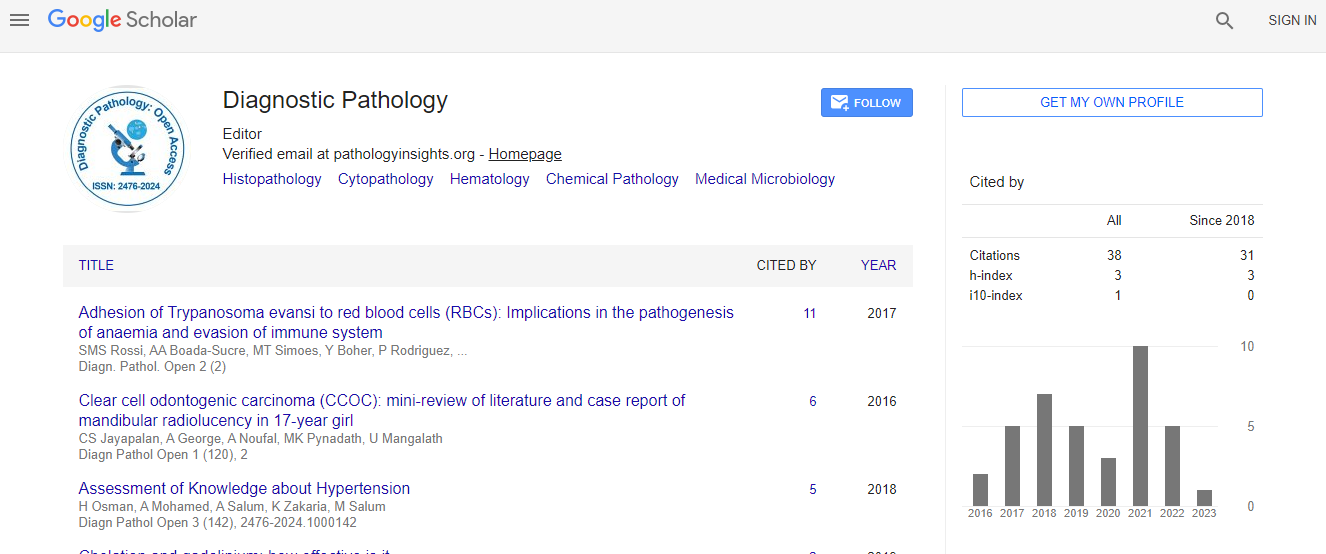Research Article
Adhesion of Trypanosoma evansi to Red Blood Cells (RBCs): Implications in the Pathogenesis of Anaemia and Evasion of Immune System
M S Rossi S 1,2,3*, A A Boada-Sucre4, M T Simoes1, Y Boher4, P Rodriguez5, M Moreno6, M Ledezma de Ruiz7, M L Marquez8, H J Finol5, C Sanoja1 and G Payares11Laboratorio de Inmunología y Quimioterapia, Instituto de Biología Experimental, Facultad de Ciencias, Universidad Central de Venezuela, Caracas, Venezuela
2Sección de Investigaciones en Patología Ultraestructural y Biología Molecular, Instituto Anatomopatológico José A. O´Daly, Facultad de Medicina, Universidad Central de Venezuela, Caracas, Venezuela
3Laboratorio de Arbovirus y Enfermedades Virales Emergentes, Centro Nacional de Microbiología, Instituto de Salud Carlos III, Madrid, España
4Laboratorio de Microscopía Electrónica, Instituto de Estudios Científicos y Tecnológicos, Universidad Nacional Experimental Simón Rodríguez, Caracas, Venezuela
5Centro de Microscopía Electronica "Mitsuo Ogura", Facultad de Ciencias, Universidad Central de Venezuela, Caracas, Venezuela
6Instituto de Investigaciones en Biomedicina y Ciencias Aplicadas, Universidad de Oriente, Cumaná, Venezuela
7Cátedra de Bioquímica, Facultad de Farmacia, Universidad Central de Venezuela, Caracas, Venezuela
8Laboratorio Cultivo de Tejidos Animales, Instituto de Biología Experimental, Facultad de Ciencias, Universidad Central de Venezuela, Caracas, Venezuela
- *Corresponding Author:
- Marcello Salvatore Rossi Spadafora
Centro Nacional de Microbiología
Instituto de Salud Carlos III, Madrid, Spain
Tel: 0034-911265512
Email: rossimarcell@gmail.com
Received Date: January 23, 2017; Accepted Date: February 06, 2017; Published Date: February 11, 2017
Citation: Rossi MSS, Boada-Sucre AA, Simoes MT, Boher Y, Rodriguez P, et al. (2017) Adhesion of Trypanosoma Evansi to Red Blood Cells (RBCs): Implications in the Pathogenesis of Anaemia and Evasion of Immune System . Diagn Pathol Open 2:122.doi: 10.4172/2476-2024.1000122
Copyright: © 2017, Rossi MSS. This is an open-access article distributed under the terms of the Creative Commons Attribution License, which permits unrestricted use,distribution, and reproduction in any medium, provided the original author and source are credited.
Abstract
Background: Trypanosoma evansi is the etiological agent of trypanosomosis, a disease of domestic (horses, cattle and goats) and wild (capybara, vampires) animals characterized by anaemia, degeneration, necrosis and inflammatory processes. This disease is of great concern because it produces growth retardation, loss of body weight, low production of animal proteins and diminished fertility and traction power. Because anaemia is considered the most characteristic symptom, the aim of this study was to assess the effects that T. evansi adhesion to erythrocytes has on their morphology, surface oligosaccharides profiles and trypanosome surface antigens.
Methods: Blood and tissues samples from mice experimentally infected, were studied using scanning (SEM) and transmission (TEM) electron microscopes and lectin's histochemistry (sConA, sWGA, PNA, LFA, etc.). Furthermore immunoprecipitation of T. evansi radio iodinated surface antigens with specific anti-hosts and anti-trypanosome sera was performed and antigens analysed by electrophoresis and autoradiography.
Results: T. evansi adhesion to erythrocytes as well as changes in the morphology of them, were frequent findings. SEM studies showed that adhesion of bloodstream trypomastigotes of T. evansi to mature erythrocytes and reticulocytes occurred through its flagellum, undulating membrane or cellular body and were mediated by filopodia. Minute pores and filamentous material were sometimes observed on erythrocytes membrane at the point of adhesion to the trypanosome. Oligosaccharides changes of RBCs glycocalix were characterized by a marked decrease in Man/Glc, terminal GalNAc and terminal Neu5Ac labelling accompanied by an increase in labelling of terminal GlcNAc. There were not labelling changes with the other lectins assayed. Preliminary immunoprecipitation studies of T. evansi radio iodinated surface antigens with anti-host sera, showed the presence of a of 45 kDa antigen from erythrocyte and host plasma on T. evansi plasma membranes. Furthermore, TEM studies demonstrated an increased abnormal erythrophagocytosis in adrenal gland, spleen and liver of experimentally infected mice.
Conclusion: Adhesion of T. evansi to erythrocytes together with morphological and biochemical changes of these cells must be responsible for abnormally incremented erythrophagocytosis. On the other hand, detection of antigens from host on T. evansi membranes, suggests the operability of the antigen masking as an alternate immune response evasion mechanism to antigenic variation described in African trypanosomes.

 Spanish
Spanish  Chinese
Chinese  Russian
Russian  German
German  French
French  Japanese
Japanese  Portuguese
Portuguese  Hindi
Hindi 
